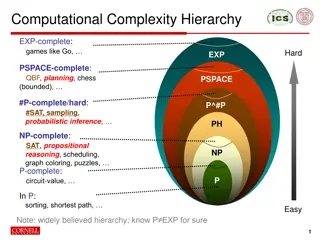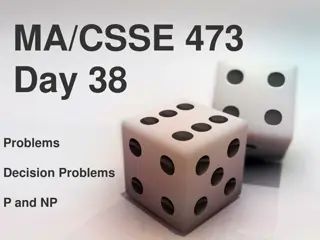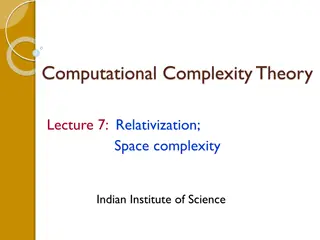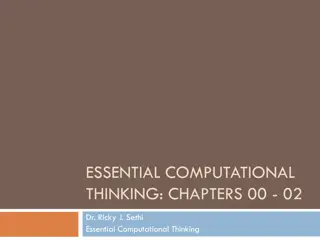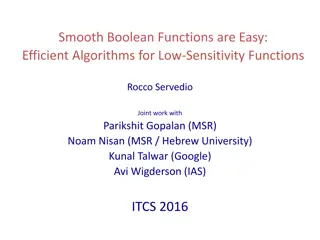Understanding Computational Complexity Through Statistical Physics
In the age of vast data growth, tackling complex computational problems is crucial. Statistical physics can provide insights into handling the new challenges arising from the exponential increase in data. As we delve into understanding the complexity of computational tasks, it becomes evident that efficient problem-solving involves navigating through tractable and intractable problems. The interplay between information processing and computational barriers shapes our quest for smarter solutions in a data-rich world.
- Computational Complexity
- Statistical Physics
- Complex Computational Problems
- Data Processing
- Tractable Problems
Download Presentation

Please find below an Image/Link to download the presentation.
The content on the website is provided AS IS for your information and personal use only. It may not be sold, licensed, or shared on other websites without obtaining consent from the author. Download presentation by click this link. If you encounter any issues during the download, it is possible that the publisher has removed the file from their server.
E N D
Presentation Transcript
How StatisticalPhysics can help Computational Complexity What can we say about the new computational challenges
We live in an era where information is gathered more than any other resource, at increasingly high rates. Complex Computational Problems Ninetypercent of the data in the world today has been created in the last two years alone. Our current output of data is roughly 2.5 quintillion bytes a day. By 2020 it s estimated that for every person 1.7MB will be created every second. 1 floppy disk per second!
Complex Computational Problems
With all this data, we can infer new incredible information about our society, optimize complex networks and design a better future. Complex Computational Problems Alas all comes with a cost. The cost of great computational barriers. To process this data is all but as simple task, especially in an era without quantum computers.
Millions of people commute by car every day; for example, to school or to their workplace. Self-driving vehicles are an exciting development for transportation. They aim to make traveling by car safer and more available while also saving commuters time. You want some examples? I give you some examples. Given a list of pre-booked rides in a city and a fleet of self-driving vehicles, assign the rides to vehicles, so that riders get to their destinations on time.
Or: You want some examples? I give you some examples. Given a fleet of drones, a list of customer orders and availability of the individual products in warehouses, schedule the drone operations so that the orders are completed as soon as possible. Or: Given a schema of a data center and a list of available servers, assign servers to slots within the rowsand to logical pools so that the lowest guaranteed capacityof all pools is maximized. Else{ Return 0 }
But what does it mean for a problem to be complex? The running time of the program is the measure for the complexity of the problem. Example: Multiplying two ? ? matrices requires ?3 multiplications. This means the problem has a complexity of ?(?3) A brief excursion through definitions Other Example: Finding all the possible combinations of ? elements requires 2?operations, this means ?(2?) Since we feel uncomfortable with anything worse than polynomial, we define the ?(??)as tractableproblems, while the others are deemed intractable.
We love classics All this problems are just complex versions of some classical computational conundrums
We love classics As an example consider the following problem from network design. You have a business with several offices and you want to lease phone lines to connect them up with each other. The phone company charges different amounts of money to connect different pairs of cities, and your task is to select a set of lines that connects all your offices with a minimum total cost.
We love classics The Minimum Spanning Tree (MST): Given a weighted graph G = ?,? with non-negative weights. Find a spanning Tree ? ? with minimum total weight. This is a tractable problem. Equipped with a polynomial algorithm you can find minimum spanning trees with thousands of nodes within seconds on a personal computer. Compare this to exhaustive search!
We love classics The Travel SalesmanProblem (TSP): Given a ? ? distance matrix with elements ??? 0. Find a cyclic permutation ? 1 ? 1 ? that minimizes ??(?) ? ??(?) = ???(?) ?=1 Assignment: Given a ? ? distance matrix with elements ??? 0. Find a permutation ? 1 ? 1 ? that minimizes ??(?)
Any optimization problem can be turned into a decision problem by adding a bound B to the instance. Examples: Hard decisions MST (DECISION): Given a weighted graph ? = (?,?) with non- negative weights and a number ? 0. Does G contain a spanning tree ? with total weight ?? TSP (DECISION ): Given a ? ? distance matrix with elements ??? 0and a number ? 0. Is there a tour with length ??
Hard decisions Imagine such an algorithm, in which you could check multiple solutions in parallel. If you could solve your problem in polynomial time like this, then it belongs to the class of Nondeterministic Polynomial Time (NP)
If furthermore its solvable by a realistic algorithm in polynomial time, it s a Polynomial Time (P) class problem Warning: this picture may be difficult to grasp Hard decisions
Thats nice and all, but physicists couldnt help but notice some details. How can we help All the computational theory is based on the worst case scenario, meaning the maximal possible computations. But that s not even remotely the most common case
How can we play with such problems? First of all we must express analytically the cost function of the system. After this, we can interpret it as a Hamiltonianand study the partition function, analyze the phase space and find mean values, phase transitions and stuff How can we help ? ??(?) = ???(?) ?=1
How can we help An example is the Matching Problem, which we can treat as a 2d- Ising model
Our help is especially appreciated in fields where nobody said anything relevant so far, such as in the study of Neural Networks. ? ?( ????) ? ? = ?1,?2, ?3, ,?? ?=1 Can we help even more? ? Inputs Output ? = ??
Our help is especially appreciated in fields where nobody said anything relevant so far, such as in the study of Neural Networks. Can we help even more?
The dimer covering of a lattice. Simple to formulate, yet hard to resolve. How does the matching between neighbors look on a lattice? A brilliant problem What s the number of such possible configurations? How does it scale? How much is the problem frustrated? What about the exited levels?
The dimer covering of a lattice. Simple to formulate, yet hard to resolve. How does the matching between neighbors look on a lattice? A brilliant problem What s the number of such possible configurations? How does it scale? How much is the problem frustrated? What about the exited levels? 1 1 1 ? = ???? K = 1
A lot of interesting properties arise when studying excited states. In general, the energy landscape is highly non trivial A brilliant problem Possible Conformal limit? SLE?
Fun fact #915: Did you know dimers could be used to describe fermions? Why not
Concluding That llbe all















